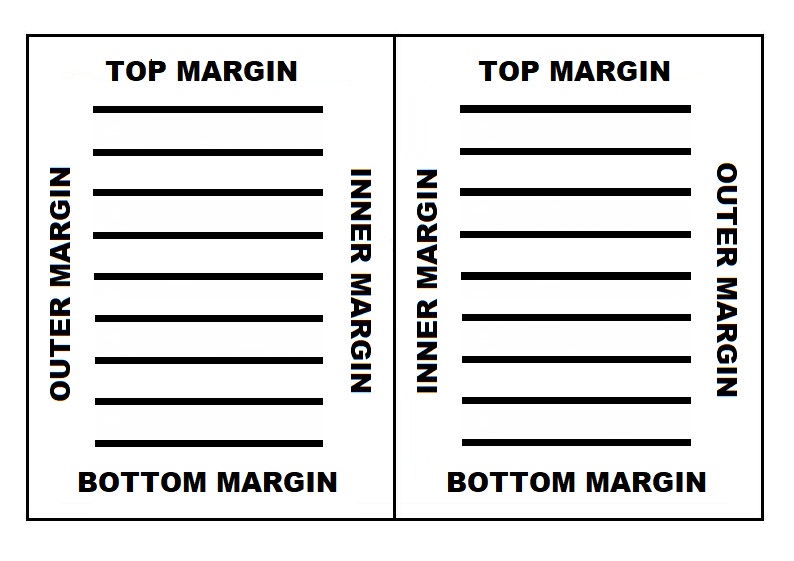Book Printing: How the Margins of a Book enhance Readability

estimated reading time: 6 minutes
Margins provide the blank space that surrounds the text and
images on the pages of a book. Each page within a book has a top margin, a
bottom margin, an outer margin, and an inner margin (see diagram). The inner
margins are located where the pages join together and are sometimes referred to
as the gutter margins.

Book Margins are more important than you might realize
When it comes to book printing, the significance of page
margins often goes unnoticed. However, these seemingly inconspicuous white
spaces that surround a book's content actually contribute a great deal to the
appearance and readability of a book.
As such, the thoughtful placement of margins actually plays
a very important role in a book's overall success. That said, below are seven
important attributes that margins contribute to the reading experience of a
book.
1. Margins frame the content to improve focus and heighten reader engagement
Margins add white space around the perimeter of each page
within a book. By framing the content in this manner, a clear boundary is established
between the lines of text and the edges of the page. Much like a picture frame
that surrounds a piece of artwork, this framing effect minimizes visual
distractions and helps to focus the reader's concentration on the subject being presented.
As a result, page margins lead to higher levels of engagement and
comprehension.

2. Margins add a sense of balance and symmetry to a book's pages
Margins help to center the content on each page. This increases the aesthetics of the book by adding symmetry and balance, not only to each individual page but also to each spread of opposing pages. The white space achieved through the use of generous margins is very inviting. It adds a feeling of openness to the pages as well as providing a uniform flow throughout the book.
3. Margins reduce eye strain by providing a visual resting place
Packing too much information on a page without providing any
visual breathing room can overwhelm the eyes, leading to strain and fatigue.
Fortunately, the proper use of page margins provides ample white space between
the printed content and the edges of the page. This acts as a sort of visual
buffer to prevent the text from appearing too cramped while also giving the
eyes a quick break at the end of each line. Having spacious margins greatly
improves the ease at which a book can be read.
4. Margins provide a space for page numbers and other
important design elements
In addition to the main content, books commonly incorporate
various design elements on each page. For example, most pages within a book
contain a page number. Page numbers provide a logical method for navigating a
book's content. Likewise, running headers or footers are often placed on each
page to identify the different chapters or sections within a book. The margins
provide the space needed to display these important elements in a clear and
consistent manner.
5. Margins allows the reader's hands to hold the book open without obstructing any text
Many books require the reader to continually hold the pages
open in order to view the printed content. If the margins are too narrow, the
hands will have to be frequently repositioned to keep from obstructing content
as each page is read. Obviously, this constant hand shifting can become
annoying and diminish the reading experience. However, this issue can be easily
avoided by having sufficient margins. The margins allow the book to be
held comfortably without any text being obscured by the thumbs or fingers.
6. Margins provide room for handwritten notes and annotations
Some readers like to occasionally add handwritten comments to the pages they are reading. These annotations help to aid comprehension and retention of the subject matter. For example, recipe books, study guides, procedural manuals, and self-help books often spur the need to add notes for future reference. By adding white space to each page, margins provide a convenient space for writing these remarks.
7. Margins give the pages a safe zone during production
During the manufacturing process, the pages of books will be
trimmed down to the desired size. Since mechanical processes can incur
vibrations or shifting that might affect a precise cut, it is important that printed content be placed well
within a trim line. Otherwise there is the risk that some information will end
up extremely close to the edge of the page after trimming, or even partially
cut off. Needless to say, this will greatly
affect the appearance of the book. However, by having adequate margins, a
buffer zone is formed around the perimeter of the pages to help prevent the
final trim from encroaching on the content.

A Word about Standard Page Margins
Though it seems there should be some absolute rules
regarding margin sizes, there doesn't seem to be a standard that everyone agrees upon. If you consult 10 different
sources, you will probably get 10 different responses. This is because margin sizes are often based on personal preference.
However, most
printed books fall somewhere between 5.5" x 8.5" and 8.5" x 11". These books will generally have
margins in the .5" to 1" range, with the margins becoming increasingly larger
as the book dimensions increase.
In addition to the width and height dimensions, margins are also affected by the thickness of the book, specifically the inner margins. This is largely due to the curvature of the pages that occurs near the gutter on certain types of books, such as perfect bound books and hard cover books.
As a result, the width of the inner margins on these types of books will need to be increased slightly to keep content from being swallowed up by the gutter. Of course, this may be hard to
visualize on a computer monitor when laying out the book because the pages will
appear flat when viewed on the screen.
Best way to determine Margin size
The recommended method for determining margin size is to visit a bookstore or library
and look at books that fall within the same genre as your book. Examine the
ones that have the same width, height, and thickness (page count) that you are planning for
your book. Then measure the margins of those books to see which margin sizes are
the most prevalent…and the most appealing to you.
The top, bottom, and outer margins will be easy to measure.
Just measure from the main body of the text to the edge of the page. Measuring
the width of the inner margin will be a little trickier, however.
To calculate the width of the inner margins, first measure
from the innermost edge of the text (the edge closest to where the pages are
bound) to the very outer edge of the page. We'll call this measurement A. Then
close the book and measure the width of the entire block of pages. We'll call this measurement B. The difference between A and B will be
the width of the inner margin.
After exploring some similarly-sized books, you will get a
good idea of the margin dimensions to use for your particular book project. By
the way, it can be very tempting to use very narrow margins for your book
because doing so may lower the page count somewhat, and possibly save money on the printing. However, margins
that are too narrow can negatively affect the book's appearance and
readability.
Since the success of your book will be determined by how
well it meets the expectations of the intended audience, you don't want skimpy
margins to diminish your audience's perception of an otherwise amazing book.
Especially one you have worked so hard to create.
Color Vision is here to help!
Since 1984, Color Vision has been producing quality books at
affordable prices. Because we have both digital and offset presses, we can
print books in short, medium, or long production runs. We also offer a wide
variety of printing, binding, and finishing options to help your book stand out
from the crowd.
If you have an upcoming book project and would like to
receive a quotation by email, please complete our Quote Request form. Or,
if you prefer to discuss your project by phone, we can be reached at 800-543-6299.
As always, we hope to hear from you soon and
look forward to assisting with your next book project!
Related Article: Helpful Advice for Page Numbering
Related Articles

Which Book Projects Benefit From Being Spiral Bound?
Read This Article

Booklet Catalogs: Why is this Catalog Format so Popular?
Read This Article

Creating a Comic Book? Here’s some Advice from a Printer
Read This Article

Perfect Binding vs PUR Binding: What is the Difference?
Read This Article